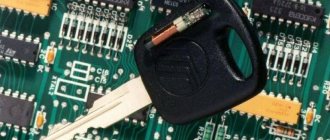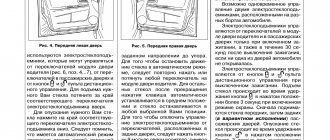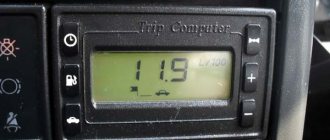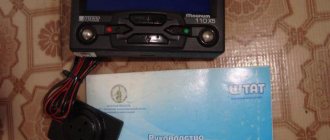For any car owner, one of the main issues is the safety of his car. Today, there are a huge number of security systems that are designed to prevent attackers from trying to take over your car. But, unfortunately, there are often cases when anti-theft devices turn against their own owners. This is especially true for built-in basic systems installed by default by the manufacturer - the so-called immobilizers.
USING ANTI-THEFT SYSTEM APS-4
On cars equipped with the APS-4 car anti-theft system (immobilizer), it is possible to switch it to an active state, in which starting the engine will be possible only with a code key, and thereby provide additional protection of the car from unauthorized use by immobilizing the engine. The set of coded keys, additionally supplied to the car, contains two black keys - working and one red - training. The keys are marked “APS-4”.
First of all, you should make sure that the anti-theft system is connected and inactive. To do this, close all the car doors except the driver's door, get into the car and close the driver's door. The interior light should remain on for another 12 seconds after the driver's door is closed, and then go out smoothly. Turn on the ignition, the system status indicator LED should light up and stay lit until the ignition is on. In this case, you can proceed to the procedure for transferring the anti-theft system to the active state, i.e. carry out the so-called “coding” of the system with code keys, which then become individual for each anti-theft system. If, when the ignition is turned on, the system status indicator LED blinks at a frequency of 2 times per second, this means that the anti-theft system on your car has already been switched to an active state earlier and you should proceed to the “Disarming” section.
ATTENTION!
If, when you turn on the ignition, the system status indicator LED does not light up, but flashes at a frequency of 1 time per second for 20 seconds, this means the following:
1. There is no electrical connection between the engine control controller and the immobilizer unit. The connection in the engine control system harness should be checked.
2. The engine control controller was previously taught code keys with another immobilizer unit. The engine will not start. You should contact a service station.
If, when the ignition is turned on, the LED does not light up, but flashes at a frequency of 5 times per second for 20 seconds, this means an error in the immobilizer unit. If this blinking does not disappear the next time the ignition is turned on, you should contact a service station.
Device types
Now there are three main types of immobilizers:
- Protective while moving (engine blocking while moving);
- Contact (the most common);
- Contactless.
The first type of immobilizers is characterized by a greater range of action, thanks to a more powerful board and antenna. Its task is to block the engine while the car is moving.
The device is actively used not only by various financial and other organizations, but also by individuals.
The bottom line is that if instead of the rightful owner, as a result of violent actions against him, there was another driver, it would be possible to block the engine while driving at a great distance. The main thing is that the control key fob remains with the owner of the car.
True, this can also be done with mobile systems via a smartphone or GPS control systems, for example, car satellite search modules.
The second type (contact immobilizers) requires the presence of a special reading board in the ignition switch and a key with a chip in which a unique code is stitched.
The disadvantage of such devices is that losing or getting the key into the wrong hands can lead to unpleasant consequences. Therefore, some car owners are forced to spend money on installing additional security measures, such as fingerprint scanning devices or a small keyboard for entering a code.
The third type is contactless immobilizers. They are more reliable in terms of protection than contact ones. The fact is that the basis here is a special chip that sends a signal from a short distance (up to 0.1 meters) to the receiving board.
The chip can be mounted in any unattractive thing, and the board can receive a signal through an antenna placed in any place known only to the owner of the car. Those. if the chip falls into the wrong hands, you also need to know where to put it in order to start the car.
Nowadays, most new car models come with standard immobilizers. They are installed at the factory, and therefore these devices are maximally integrated into the electronics and design of the machine.
But if they do not meet the car owner’s safety criteria, you can additionally install another immobilizer as an anti-theft device.
TRAINING ANTI-THEFT SYSTEM WITH CODE KEYS
After you are convinced that the anti-theft system is in an inactive state, you can proceed to the procedure for learning (coding) code keys. To do this, follow these steps:
1. Turn on the vehicle ignition; the system status indicator LED should light up continuously within 5 seconds. 2. Bring the red code key marked APS-4 to the indicator. 3. While holding the red code key, turn off the ignition. The LED should remain lit and the control unit buzzer will emit a short beep. 4. Remove the red code key from the indicator. No later than 5 seconds after turning off the ignition, the LED should flash at a frequency of 10 times per second. If this does not happen, you should wait at least 15 seconds without turning on the ignition and return to repeating step 1. 5. No later than 20 seconds after the LED starts blinking, bring the first black code key marked APS-4 to the indicator. The buzzer should emit a beep for about a second, and the LED will turn off during this time. 6. Remove the trained black key. No later than 20 seconds after the LED resumes flashing, bring another black key. The buzzer should emit a beep for about a second, and the LED will turn off during this time. Note. The anti-theft system allows you to train up to four black coded keys. The procedure for training them should be repeated according to paragraph 6. 7. Remove the second trained black key and no later than 20 seconds, bring the red key to the indicator. The LED will light up and the buzzer will beep. Remove the red key from the indicator. 8. No later than 15 seconds after the LED turns on, turn on the car's ignition. If your car has an M1.5.4 or January-5 controller installed, then no later than 3 seconds the LED will go out and the buzzer will sound a beep. Then turn off the ignition. If the MP7.0 controller is installed, then after 3 seconds after turning on the ignition, the LED will continue to light. No later than 10 seconds later, while the LED is on, turn off the car's ignition. The LED will turn off and the buzzer will beep. 9. Wait with the ignition off for at least 6 seconds. 10. Check the trained anti-theft system. To do this, turn on the car's ignition, the buzzer should emit a sound signal, and the indicator LED should blink at a frequency of 2 times per second. Carry out a test start of the engine for 3...5 seconds; the engine should not start. Turn off the ignition, wait at least 6 seconds and repeat the test start of the engine; the engine should not start.
Note. If the engine starts, this means that the learning procedure was not completed correctly or the waiting time was exceeded at some interval and the anti-theft system automatically returned to its original inactive state. In this case, the learning procedure should be repeated, but before each repetition of learning, you must turn off the ignition for at least 15 seconds.
11. Turn off the ignition, no later than 10 seconds after turning off the ignition, bring one of the trained black keys to the indicator, the buzzer should emit 2 beeps and the LED should go out. Turn on the ignition and test run the engine, the engine should start. 12. Turn off the ignition, open and close the driver's door. After 15 seconds, the buzzer should emit a sound signal at an accelerating pace for another 15 seconds, and the indicator LED should light up with a flickering light, which indicates that the automatic immobilization mode (engine start blocking) is in progress. After this time, the buzzer stops sounding and the LED goes into flashing mode once every 2.5 seconds.
Safety Notes
A standard device such as the APS provides the best level of protection. But an alarm system, even the most modern one, can be considered only an additional security device. It does not exchange data with the ECU and does not prevent the engine from starting. At the same time, when installing an alarm system with auto-start, blocking is always implemented. Two cords going to the main unit are connected to the starter cable. And until the security is turned off, you cannot start the engine.
Typical signaling connection diagram
All wiring connected to the ignition switch carries significant current. But doing the installation yourself does not always ensure good quality connections. In general, it is better to entrust the autostart connection to an experienced electrician. We wish you success.
DISARMING
To disarm the anti-theft system and start the engine:
1. Open or close the driver's door, or turn the ignition on and off. In this case, the system goes into the “reading” mode of the key code, and the system status indicator LED blinks at a frequency of 2 times per second. If you switch to the “reading” mode by turning on the ignition, the buzzer will emit a short sound signal.
2. In the “reading” mode, which lasts 1.5 minutes if the door was manipulated or 10 seconds if the ignition was turned off, you should bring “your” working key to the indicator. After the system reads and recognizes the key code, the LED goes out and the buzzer emits a double beep. When the LED turns off, the engine can start.
3. Turn on the ignition, the LED will light up briefly and go out, the engine should start.
How to make a crawler yourself?
Any immobilizer bypass imitates a signal received for unlocking. You can make the device yourself using a control relay, a complete tag, a second key and a wire.
- The key and tag perform the task of simulating engine unlock signals.
- An electromagnetic coil is made from wire, with the help of which access to the on-board network is provided.
- The control relay automatically sets the unlocking response time.
Everything should work by default when the module is active or automatically.
ARMING
The anti-theft system switches to security mode automatically after the ignition is turned off and depends on the situation and the actions of the driver. If the driver's door was not opened or was open and not closed, then arming occurs after 5 minutes; if the driver's door was open and closed, then arming occurs 30 seconds from the moment the door is closed.
In all cases, 15 seconds before arming the system, the buzzer starts beeping at an accelerating pace. If arming is not desired, then you must turn the key to the “ignition” position.
SPECIAL SITUATIONS
Lost working black key.
If a working key is lost, it is recommended to retrain the second remaining working key so that the lost key cannot be used to steal a car. Then you can buy a second key and retrain the system again with two keys. Retraining is carried out according to the procedure described in the section “Training the anti-theft system with code keys”, the only difference is that when the ignition is turned on at the beginning of the procedure, the system status indicator begins to blink at a frequency of 2 times per second.
Lost training red key.
If the training key is lost, it is impossible to carry out the procedure for learning new keys. This means that you can continue to operate the car with the existing working keys, but if they are lost or if the immobilizer control unit malfunctions, you will have to
replace both the immobilizer control unit and the engine control controller with new, untrained ones. With such a replacement, you can take a new training key and carry out the procedure for training the anti-theft system with working code keys. Due to the importance of the training key, it is recommended that you keep it in a safe place at home.
Replacement of a faulty anti-theft system control unit (immobilizer).
After replacing a faulty immobilizer with a new one, it is necessary to carry out the system training procedure described in the section “Training the anti-theft system with code keys”. You should use the existing training key for the faulty immobilizer. However, there is a difference in paragraph 1 of the training section, which is that after turning on the ignition, the LED blinks at a frequency of 1 time per second.
Replacing a faulty controller.
If the controller malfunctions, it can be replaced with a new “clean” one. In this case, the new controller will allow the engine to start regardless of the immobilizer. To enable the anti-theft function, you must follow the procedure described in paragraph 1 “Loss of a working black key” using the existing training and working keys.
The engine does not start.
If, after disarming the anti-theft system when starting the engine, the system status indicator LED flashes at a frequency of 1 or 5 times per second, and the engine does not start, it means that the anti-theft system is faulty, or there is no connection between the immobilizer unit and the engine control controller. If, when starting the engine, the LED flashes 1-2 times and goes out, but the engine still does not start, then the malfunction is not related to the anti-theft system.
Interior lamp delay control
This function allows you to maintain interior lighting for some time after closing the car door, which makes it easier for the driver to operate in the dark. For this function to work, the lamp switch must be turned off. In this state, when the driver's door is opened, the lamp lights up and stays on as long as the driver's door is open. If the car's ignition is not turned on, then after closing the driver's door, the lamp remains on for another 12 seconds, after which it goes out smoothly within 4 seconds. If the door closes while the car's ignition is on, the courtesy light turns off immediately after the door is closed. If you turn the ignition key to the “on” position during the lamp shutdown delay, the lamp will go out without delay. If the door is opened again during the lamp shutdown delay, the lamp turns on and lights up as long as the door is open, and then as described above.
How does an immobilizer differ from a regular alarm system?
The main difference between an immobilizer and an alarm system is its shorter range of action and a more advanced, one might say, intelligent principle of protection. All this significantly reduces the likelihood of car theft.
For example, in order to intercept a signal coming from the key fob of a conventional security system, an attacker can be located at a considerable distance from the car - several tens of meters.
This will not work with an immobilizer; to intercept the signal you need to be directly next to the car, and this limits the possibilities of car thieves significantly.
Another advantage of the immobilizer is the almost impossibility of copying it, because for this you will need a special master card, which cannot be said about alarm key fobs, which in our time, by knowledgeable people, can simply be duplicated.
ALTERNATIVE ENGINE STARTING PROCEDURE
This procedure allows you to start the engine for one trip without reading the code from the working (black) key in case of its loss or malfunction of the anti-theft system. The procedure becomes possible only when the car owner himself allows it, by programming a “bypass password” consisting of six digits.
Depending on which controller is installed on your car, learning the “bypass password” and the method of bypassing immobilization is performed in two different ways.
Aps4 - immobilizer for cars, instructions, positive qualities in terms of appearance and operation
Each immobilizer has its own distinctive features and operating features. The aps4 model is designed to work with domestic transport - VAZ cars. This immobilizer is a small, electronic device that must be connected to the vehicle systems by connecting wires. The efficiency of the immobilizer is high, the quality indicators are at the highest level. To install and use the immobilizer, you need to replenish the supply of important information about this model, and those who wish to do so will do this right now.
IF A BOSCH MP7.0 CONTROLLER IS INSTALLED
Training the “bypass password”:
1. The anti-theft system is armed. Prepare a six-digit password with which you want to train the system. Each digit can be from 1 to 9. 2. Turn on the ignition. The “Check Engine” (CE) lamp on the instrument cluster will illuminate continuously. The system status indicator LED will flash 2 times per second. 3. Bring “your” red key to the system status indicator and hold it, turn off the ignition. The LED will light up continuously and the buzzer will emit a short beep. Remove the key from the indicator. 4. 3...5 seconds after the ignition is turned off, the indicator LED will start blinking at a frequency of 10 times per second. 5. No later than 10 seconds after the LED starts blinking, turn on the car’s ignition, the CE lamp will blink once per second, which indicates entering the “bypass password” input mode. 6. Wait 4 minutes for the CE lamp to flash, then the lamp turns off for 1 minute. During this time, enter the first digit of the password by pressing the accelerator pedal all the way. You need to press as many times as the first digit of the entered password. Each time you press the pedal, the CE lamp comes on. After a minute has passed, the lamp resumes flashing again for another 4 minutes. 7. Wait 4 minutes until the CE lamp flashes, then repeat the number entry procedure for the second digit of the password and so on until the last sixth digit of the password is entered. If any number is not entered, then after 1 minute the lamp will begin to flash at a frequency of 1.5 times per second. You must turn off the ignition for at least 15 seconds, then start learning again. If all numbers are entered correctly, then after the last minute the CE lamp will no longer turn on. 8. Turn off the ignition for at least 15 seconds.
ATTENTION!
1. The entered bypass password has no restrictions on its use, i.e. Once programmed, the password can be used many times.
2. If the password is not entered completely, it is not remembered.
3. If you want to prohibit the procedure for alternative engine starting programmed earlier, then you should:
— repeat steps 1...5, but in step 6 do not press the accelerator pedal. After 1 minute has elapsed for entering the first digit of the password, the CE lamp will begin to flash at a frequency of 1.5 times per second. Turn off the ignition for at least 20 seconds. The previously programmed password will be erased.
USING THE BYPASS PASSWORD:
Bypassing immobilization is performed if the anti-theft system is faulty or “its own” code key is missing.
1. Turn on the ignition. The CE lamp is constantly on. 2. Wait 4 minutes until the CE lamp goes off. 3. Within 1 minute, enter the first digit of the “bypass password” by pressing the accelerator pedal a number of times equal to the first digit. Each time you press the pedal, the CE lamp comes on. 4. If the number is entered correctly, then after a minute the CE lamp will turn on and remain on for another 4 minutes. If the number is entered incorrectly, the lamp will blink at a frequency of 1.5 times per second, which means the bypass procedure is canceled, in this case you should turn off the ignition and return to step 1. 5. Repeat steps 2…4 for the next five digits of the “bypass password”. 6. After the last minute of entering the password number, without turning off the ignition, start the engine.
ATTENTION!
The controller will operate in immobilization bypass mode until it is completely turned off, which occurs 15 seconds after the ignition is turned off. The engine can be started multiple times if 15 seconds have not passed since the ignition was turned off, after which it becomes impossible to start the engine without performing the bypass procedure.
IF A JANUARY-5.1 OR M1.5.4 CONTROLLER IS INSTALLED
Training the “bypass password”:
1. The anti-theft system is armed. Prepare a six-digit password that you want to train the system with. Each digit can be from 1 to 9. 2. Turn on the ignition. The “Check Engine” (CE) lamp on the instrument cluster will illuminate continuously. The system status indicator LED will flash 2 times per second. 3. Bring “your” red key to the system status indicator, and while holding it, turn off the ignition. The LED will light up continuously and the buzzer will emit a short beep. 4. 3...5 seconds after the ignition is turned off, the indicator LED will start blinking at a frequency of 10 times per second. 5. No later than 10 seconds after the LED starts blinking, turn on the car’s ignition, the CE lamp will light up continuously. 6. Wait 1 minute until the CE lamp goes off. Enter the first digit of the password by briefly pressing the accelerator pedal all the way. You need to press as many times as the first digit of the entered password. Each time you press the pedal, the CE lamp comes on. The time the pedal is held down should be no more than 3 seconds. 7. To proceed to entering the next digit, press the accelerator pedal all the way and hold it in this position until the CE lamp goes out, this time is approximately 5 seconds. Release the accelerator pedal.
ATTENTION!
If the CE lamp does not go out, but flashes once per second, it means that an error occurred when entering the password number, for example, you pressed the accelerator pedal more than 9 times or did not press the pedal once for 1 minute. In this case, you need to turn off the ignition for at least 10 seconds and start learning the “bypass password” again.
8. Enter the remaining five digits of the password. After entering each digit and holding the accelerator pedal down for more than 5 seconds, the CE lamp should go out. If the lamp flashes, turn off the ignition for at least 10 seconds and then start learning the “bypass password” again. 9. Turn off the ignition for at least 10 seconds.
ATTENTION!
1. The entered bypass password has no restrictions on its use, i.e. Once programmed, a password can be used many times 2. If the password is not entered completely, it is not remembered. 3. If you want to disable the immobilization bypass mode programmed earlier, then you should repeat steps 2...6, but in step 6, when you press the accelerator pedal for the first time, hold it for more than 5 seconds. The previously programmed “bypass password” is erased.











